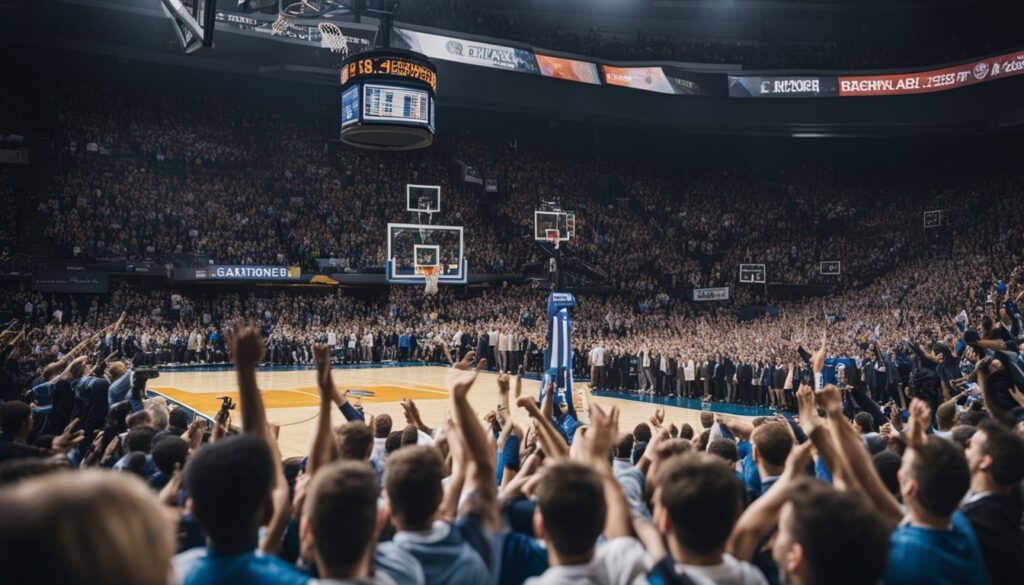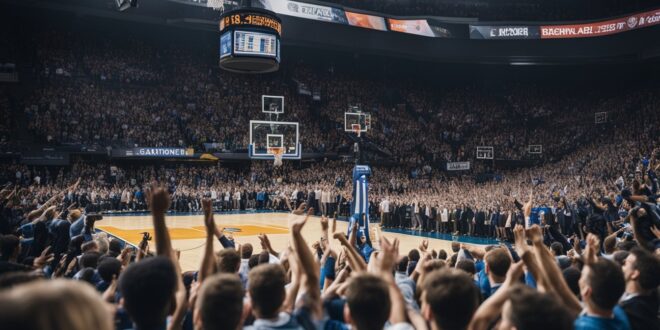It’s that time of year once more when the discuss buzzes with energy and ball fever holds the country. Walk Franticness is upon us, and for millions of fans, it’s not fair a tournament it’s an exciting travel filled with upsets, Cinderella stories, and heart-stopping minutes. But are you prepared to plunge into the madness?
Whether you are a prepared bracket-filler or an inquisitive newcomer, exploring the NCAA Men’s Ball Championship can be overpowering. With 68 groups competing for wonderfulness, how do you make sense of it all? From understanding the essentials to creating the idealized bracket methodology, from recognizing dim steeds to locks in with individual fans, this direct will equip you with everything you wish to completely submerge yourself within the Walk Franticness involvement. Get prepared to investigate the ins and outs of this cherished wearing occasion, find key players to observe, and learn how this yearly marvel impacts not fair sports but also culture and financial matters. Let’s set out on this invigorating ball enterprise together. This article will dive into the wealthy history, the social noteworthiness, the structure of the competition, and the sheer fervor that comes with Walk Madness.
The history and progression of the tournament
March Madness, definitively known as the NCAA Division I Men’s Ball Competition, includes an affluent history dating back to 1939. What began as an 8-team competition has grown into a 68-team event that captivates the nation each spring.
Key breakthroughs within the tournament’s evolution:
1939: To begin with, the competition was held, won by Oregon
1951: Field extended to 16 teams
1975: Field extended to 32 teams
1985: Field extended to 64 teams
2011: Field extended to 68 groups (current format)
The tournament’s notoriety has skyrocketed over the decades, getting to be a social marvel and winning the moniker “Walk Franticness” within the 1980s.
Year Number of Teams Winner
1939 8 Oregon
1951 16 Kentucky
1975 32 UCLA
1985 64 Villanova
2011 68 Connecticut
How groups qualify for Walk Madness
Teams can secure a spot within the competition through two fundamental avenues:
- Automatic bids:
- Winning their conference tournament
- Being the regular-season winner (in a few conferences)
- At-large bids:
- Selected by the NCAA Choice Committee
- Based on components such as by and large record, quality of plan, and quality wins
The bracket framework explained
The 68-team field is isolated into four districts, each containing 16-17 groups. The bracket framework works as follows:
- First Four: Eight groups compete in play-in games
- Round of 64: 32 diversions narrow the field to 32 teams
- Round of 32: 16 recreations decrease the field to 16 teams
- Sweet Sixteen: 8 diversions deciding the First class Eight
- Elite Eight: 4 diversions choosing the Ultimate Four
- Final Four: 2 semifinal diversions driving to the championship
- National Championship: The ultimate diversion delegated the champion
Key dates and venues
March Madness regularly lasts approximately three weeks, with games held at different settings over the nation. The competition comes full circle within the Last Four and National
Analyzing group measurements and performances.
When filling out your Walk Franticness bracket, analyzing group measurements and exhibitions is pivotal. Here are key measurements to consider:
Win-loss record
Strength of schedule
Points per diversion (offense and defense)
Field objective percentage
Three-point shooting percentage
Free toss percentage
Rebounding margin
Turnover Championship Diversion, held at a foreordained area that changes each year.
Statistics Importance What it Indicates
Win-Loss Record High Overall Team Success
Strength of Schedule High Quality of Opponent Faced
Points Per Game Medium Offensive/Defensive Efficiency
Field Goal Percentage Medium Shooting Accuracy
Rebounding Margin Medium Team’s Ability to control the glass
Considering authentic upsets and Cinderella stories

The Rise of the “Huge Dance”
As the competition extended, so as well did the media scope and open intrigued. What started as a territorial occasion turned into a national wonder. By the 1980s, the competition had gotten to be synonymous with spring break, with fans over the nation filling out brackets, observing diversions, and shaping office pools.
The expression “The Huge Move” became popularized amid this time, symbolizing the perfection of the season and the amazing organization where teams seem demonstrate themselves on a national level. Whereas Walk Franticness has regularly been related with the fervor of Cinderella stories and buzzer-beaters, the term “Huge Move” moreover reflects the gravity of the event. It isn’t fair to call a tournament it’s a celebration of ability, cooperation, and the culmination of a long time of difficult work by the student-athletes.
The Underdog Stories: Cinderella Teams
One of the key elements that has made Walk Franticness such a adored occasion is the predominance of underdog stories. Each year, groups that are considered “lesser” programs rise to the event and drag off stunning triumphs. These Cinderella stories are regularly the foremost talked-about minutes of the competition and donate fans something to rootfor past the top-ranked teams.
Perhaps the foremost popular Cinderella group is the 1983 North Carolina State Wolfpack, driven by coach Jim Valvano. NC State entered the competition as a 6th seed and confronted a intense street to the championship. Along the way, they vanquished powerhouses like Houston and Virginia, with the ultimate win over the intensely favored Houston group gaining them a national title. Valvano’s exuberant celebration, broadly running around the court in bliss after the triumph, got to be an famous picture in Walk Franticness history.
Another outstanding Cinderella story happened in 2018 when the College of Maryland-Baltimore Province (UMBC) Retrievers made history by getting to be the first-ever 16th seed to overcome a 1st seed within the competition. UMB’s staggering disturbed to Virginia was a watershed moment within the history of the competition, checking the erratic nature of Walk Franticness. The Retrievers win was an update that anything can happen, and no team is secure once the competition begins.
These underdog triumphs charm fans, reminding them of the capriciousness that creates Walk Franticness so compelling. It’s a tournament where the underdog is never really out of the battle, where lower-seeded groups have the chance to create their stamp on the war, and where any diversion can conclusion in a disturbed conclusion.
March Madness is celebrated for its erratic nature. When filling out your bracket:
Research past competition upsets.
Look for groups with comparative profiles to past Cinderella stories.
Consider groups that have performed well in later tournaments.
Don’t neglect mid-major conference champions.
Factoring in wounds and group dynamics
Team well-being and chemistry play a critical part in competition victory. Pay consideration to:
Recent wounds to key players
Return timelines for harmed players
Team cohesion and leadership
Experience in high-pressure situations
Balancing intestine sentiments with data-driven decisions
While insights are critical, do not disregard your instincts. Combine the expository approach with intuition:
Use information to illuminate your choices.
Trust your information on college basketball.
Consider factors like coaching and group momentum.
Don’t be anxious to choose a couple of upsets based on your intestine feeling.
Now that we’ve secured techniques for filling out your bracket, let’s look at a few of the beat groups and players to observe in this year’s competition.
Powerhouse programs with championship potential
The scene of men’s college ball is overwhelmed by a few powerhouse programs that reliably compete for the national championship. These groups combine first-class ability, experienced coaching, and a winning convention that creates them lasting contenders.
Program Key Strengths Notable Players
Duke Recruiting, Coaching Zion Willaimson
Kentucky NBA-Ready Talent Anthony Davis
Kansas Consistency, Depth Ochai Agbai
Gonzaga Offensive Efficiency Chet Holmgren
Breakout stars are making waves in college basketball.
Every year, modern gifts develop on the national arrange, captivating fans and scouts alike. These breakout stars frequently lead their groups to startling victory and boost their possess NBA draft prospects.
- Guards with uncommon scoring ability
- Versatile advances that can affect the amusement on both ends
- Centers who overwhelm the paint and secure the rim
- Underdog groups are competent of astounding upsets
March Madness is famous for its unusualness, with lower-seeded groups as often as possible toppling favorites. These underdogs regularly possess:
- Strong group chemistry
- Experienced upperclassmen leadership
- A one-of-a-kind playing fashion that catches adversaries off guard
- Hot shooting streaks can overcome ability disparities
- Coaches with demonstrated competition success
- Behind each effective group may be a coach who knows how to explore the weights of Walk Franticness.
These prepared pioneers have a track record of:
- Making vital in-game adjustments
- Preparing their groups rationally for high-stakes situations
- Developing amusement plans that misuse adversary weaknesses
- Maximizing their roster’s potential through compelling rotations
- As we see ahead to the competition, these coaches will play a significant part in their teams’ victory, possibly directing them to profound runs and, indeed, championship eminence.
You can also read this: The Phillies defeated the Washington Nationals 7-3, marking a successful start to their NL East title defense.

The Iconic Moments
March Madness is celebrated for its notorious minutes, minutes that go down in history and characterize the competition. These minutes come in numerous forms dramatic last-second shots, buzzer-beaters, Cinderella groups resisting the chances, and indeed warmed contentions between powerhouse programs.
One of the foremost vital minutes in Walk Franticness history came in 1985, when the Villanova Wildcats pulled off one of the foremost momentous upsets in competition history. As a #8 seed, Villanova confronted the intensely favored Georgetown Hoyas within the national championship diversion. In a diversion filled with pressure and show, Villanova shot an astonishing 78.6% from the field, vanquishing Georgetown 66-64 in a diversion that numerous still consider the most prominent championship diversion ever played.
Another famous minute came in 1992 when Christian Laettner of Duke hit a buzzer-beating shot to overcome Kentucky within the East Territorial Last. Laettner’s shot, often regarded as one of the most noteworthy in college ball history, secured a spot for Duke within the Last Four and cemented his put in Walk Franticness lore.
In 2016, Villanova was given another heart-stopping minute when it crushed North Carolina in the national championship game. With as it were 4.7 seconds cleared out, Kris Jenkins hit a three-pointer at the buzzer, fixing Villanova’s moment national title and sending the ball world into a frenzy.
These minutes, among numerous others, are what make Walk Franticness so extraordinary. It’s a competition where heroes are made and legacies are created, all interior the span of a few exciting recreations. The excited highs and lows experienced by players, coaches, and fans alike are a affirmation of the unparalleled vitality of the competition.
The Commerce of Walk Madness
While Walk Franticness could be a celebration of ball, it is additionally a enormous commerce operation. The NCAA competition generates millions of dollars in income through tv contracts, promoting, ticket deals, and sponsorships. Systems like CBS, Turner Sports, and ESPN spend billions of dollars to broadcast the competition, coming to an evaluated 200 million watchers worldwide.
Corporate sponsors too play a gigantic part within the tournament’s victory, with companies like Coca-Cola, Nike, and AT&T marking profitable bargains to publicize their brands amid the recreations. The Ultimate Four and national championship diversion are a few of the most-watched sports occasions within the world, and companies are energetic to capitalize on the presentation given by the tournament.
March Franticness could be a money related bonanza not only for the NCAA but moreover for the colleges included. Groups that make it to the afterward rounds of the competition get significant money related rewards, which are at that point dispersed to their athletic divisions. The tournament’s victory has too made college ball programs more profitable, with expanded intrigued in enlisting and fundraising.
The Social Impact of Walk Madness
Beyond the amusement itself, Walk Franticness features a critical social and social effect. It’s a time when communities come together to celebrate the wear and cheer on their groups. Workplaces, bars, and living rooms are filled with fans talking about their brackets, observing diversions, and locks in in neighborly competition. Walk Franticness cultivates a sense of solidarity, with fans from all over the nation coming together to witness the thrills of the tournament.
In expansion, the NCAA competition highlights the devotion of student-athletes who adjust scholastics with the requests of playing at the most elevated level of college ball. Whereas the competitors are frequently celebrated for their aptitudes on the court, numerous moreover exceed expectations within the classroom, exhibiting the adjust between sports and academics that characterizes college sports.
The competition, moreover serves as a stage for social issues. Over the long time, March Madness has permitted players to utilize their stage to address societal issues, whether it’s supporting social equity or raising awareness of almost imperative causes.
Conclusion
March Franticness is more than fair a ball competition. It’s a celebration of the soul of competition, the show of the sport, and the capriciousness that makes college ball so exciting. From the primary diversion in 1939 to the present-day display, Walk Franticness has captured the hearts and creative energies of millions of fans around the world. Whether it’s the Cinderella groups, the buzzer-beaters, or the famous minutes carved in history, the tournament remains a confirmation of the control of sports to bring individuals together and make extraordinary encounters.




